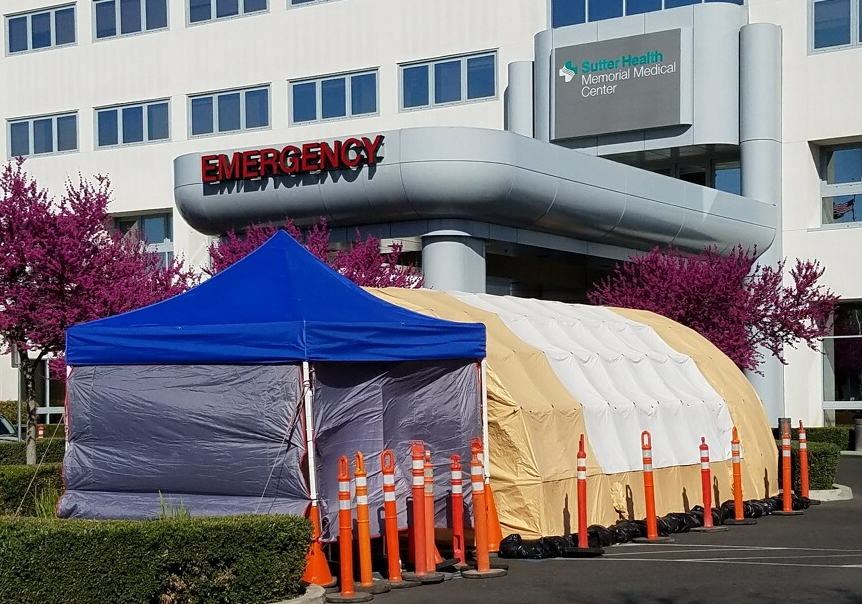California Governor Gavin Newsom recently unveiled a guide outlining when and how California may lift various coronavirus restrictions based on a set of six criteria, including hospitals’ ability to handle any potential COVID-19 patient surges. However, Newsom cautioned against moving too fast, saying “we can’t get ahead of ourselves.”
While social distancing guidelines and sheltering in place orders appear to be helping flatten the curve in California, we don’t know whether recently reported holiday gatherings for Passover or Easter that were outside these guidelines, may cause spikes in COVID-19 cases.
Integrated healthcare networks—like Sutter Health—have built-in support mechanisms that will help the network respond and take care of patients.
“We chose healthcare because we want to make a difference in the lives of others,” said Conrad Vial, M.D., chief clinical officer for Sutter Health. “We have the privilege of doing this every day but it is even more apparent during this extraordinary time in our history. Everyone in our network is prepared to serve patients and our communities.”
Integrated networks like Sutter Health allow teams to shift quickly so hardest-hit areas can receive the necessary resources like personal protective equipment, ventilators and beds. Sutter’s surge planning efforts will allow the network to expand its critical care capacity by two to three times. This is thanks in part to having the access to the best-available statistical models and the benefit of lessons learned in areas experiencing high rates of COVID-19 including Italy, New York, Singapore and South Korea. For example, Sutter’s surge plan doubles its current ICU capacity through that the use of operating rooms, post-anesthesia care units and other spaces. While all 24 hospitals are capable of taking care of COVID-19 patients, it will also focus the first phase of critical care capacity at its six largest facilities: Alta Bates Summit Medical Center in Oakland, California Pacific Medical Center in San Francisco, Memorial Medical Center in Modesto, Mills-Peninsula Medical Center in Burlingame as well Sutter Medical Center, Sacramento and Sutter Roseville Medical Center.

Sutter’s electronic intensive care unit (eICU) allows for monitoring a large number of critical care patients from a single location. The expansive telemonitoring program ensures intensive care unit patients in large cities and small towns have 24/7 access to a team of doctors and nurses specially trained in the care of ICU patients. From two central hubs, in Sacramento and San Francisco, these doctors and nurses help to monitor patients in intensive care units hundreds of miles away, using live interactive video, remote diagnostic tools and other specialized technologies to assess critical changes in a patient’s condition.
Supported by a comprehensive electronic health record, clinicians within the Sutter network can access vital information to care for 3 million patients. Similar to its ability during recent wildfires, Sutter can fill prescriptions, reschedule appointments and keep vital chemotherapy infusions on track, to ensure continuity of care for all our patients, even in the middle of a patient surge.
Additionally, to prepare for a surge of COVID-19 positive patients Sutter has:

• Postponed elective surgeries that can be safely postponed to free up supplies, staff and space;
• Increased supplies of PPE and essential equipment like ventilators;
• Set up surge tents to treat respiratory patients away from the general population;
• Created a COVID-19-specific advice line—1-866-961-2889— to triage patients before they’re seen in person;
• Increased video visit capacity to prevent sick patients from infecting other patients and staff;
• Established drive-through testing for patients who have a doctor’s order and meet criteria for testing;
• Utilized Sutter’s internal labor staffing pool, retraining employees and bringing in more advanced practice clinicians and travel nurses to support staffing needs; and
• Supported remote radiology so Sutter radiologists may interpret studies from home, increasing timeliness and access to imaging services. This can be especially helpful as critically ill patients may require chest CT scans.
“Our Sutter teams have devoted countless hours toward the rapidly changing environment this pandemic has created and we will continue to respond effectively and compassionately,” said Dr. Vial. “While we can’t predict the exact path of COVID-19, our commitment to staff and patients never changes.”





